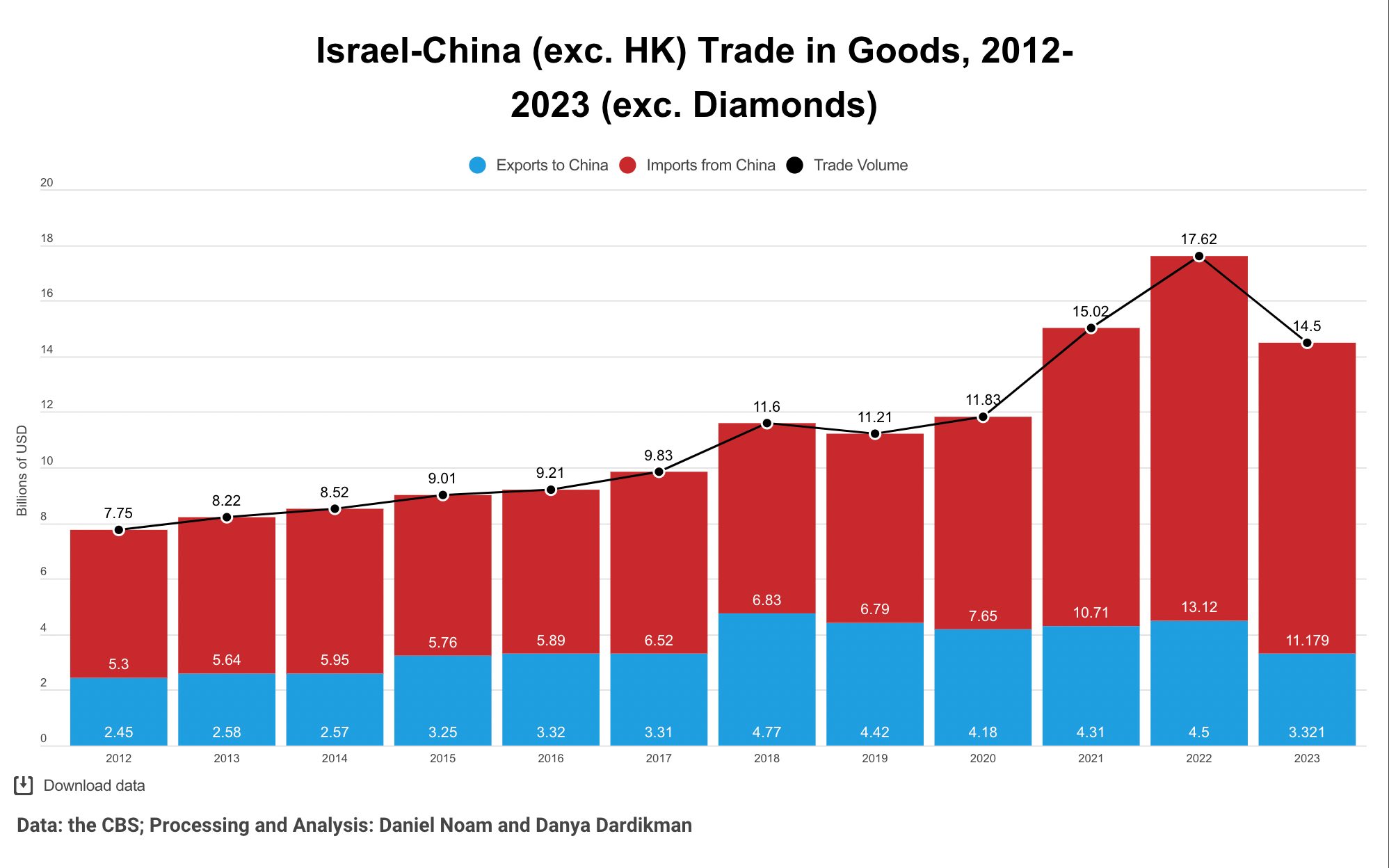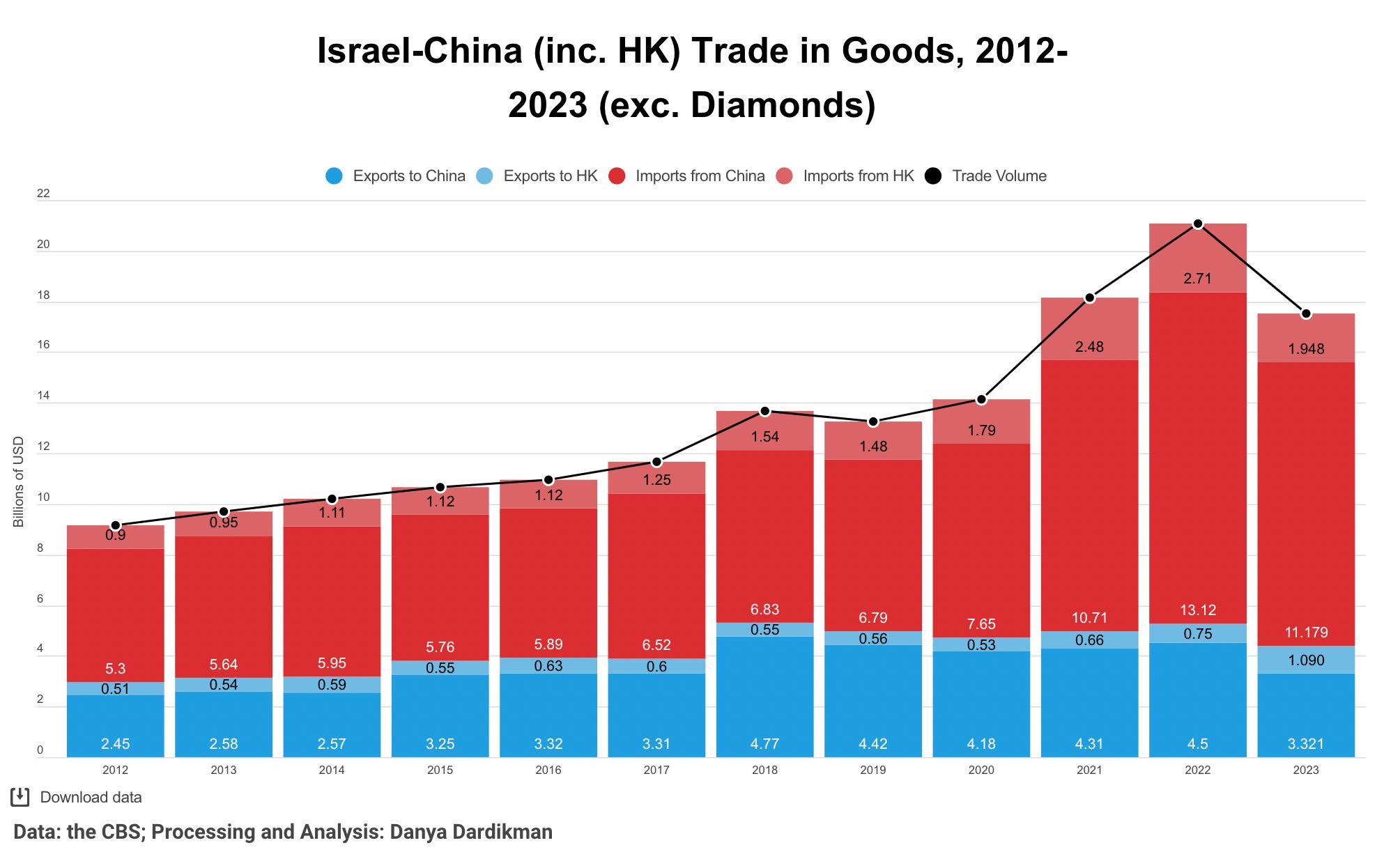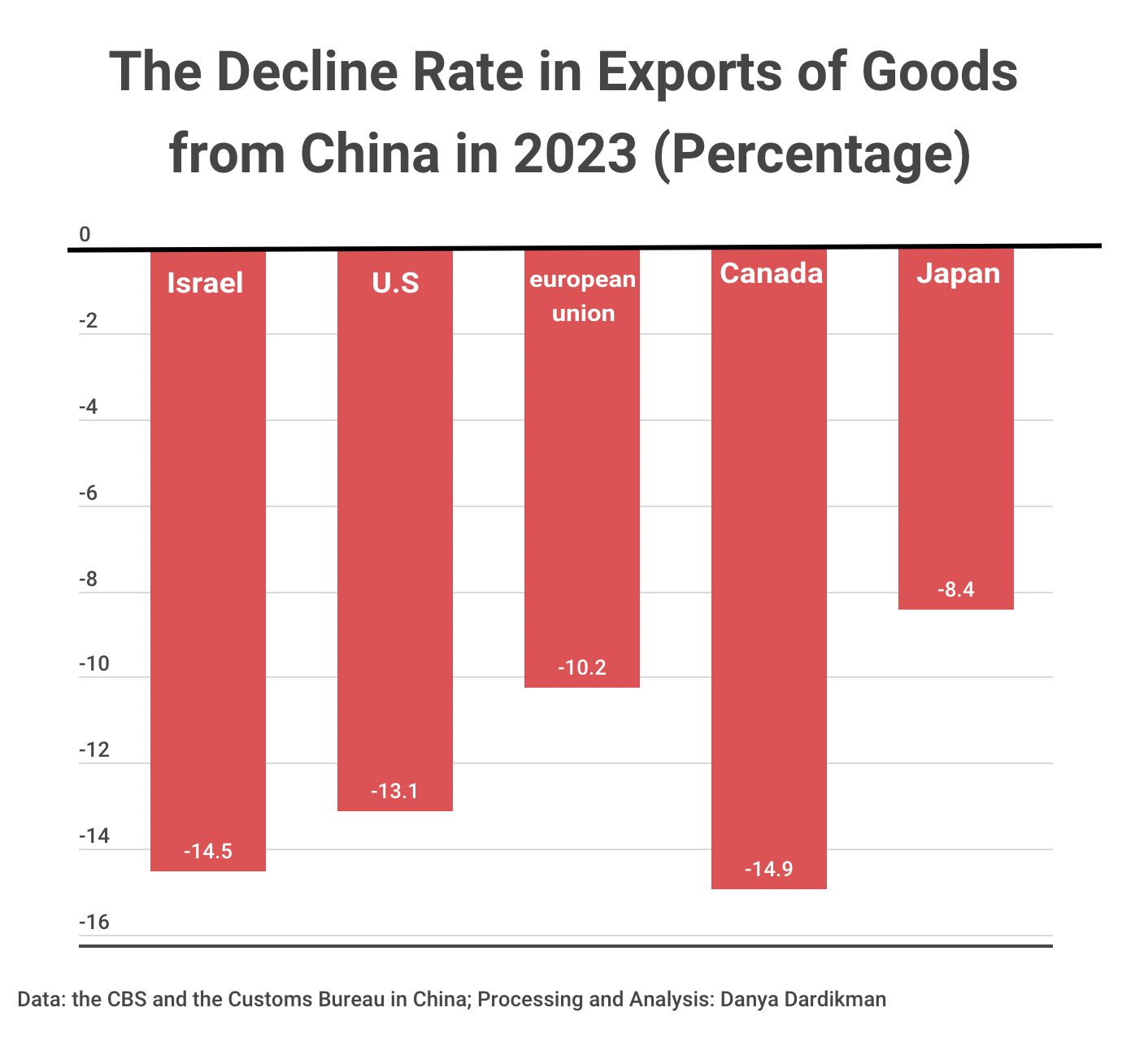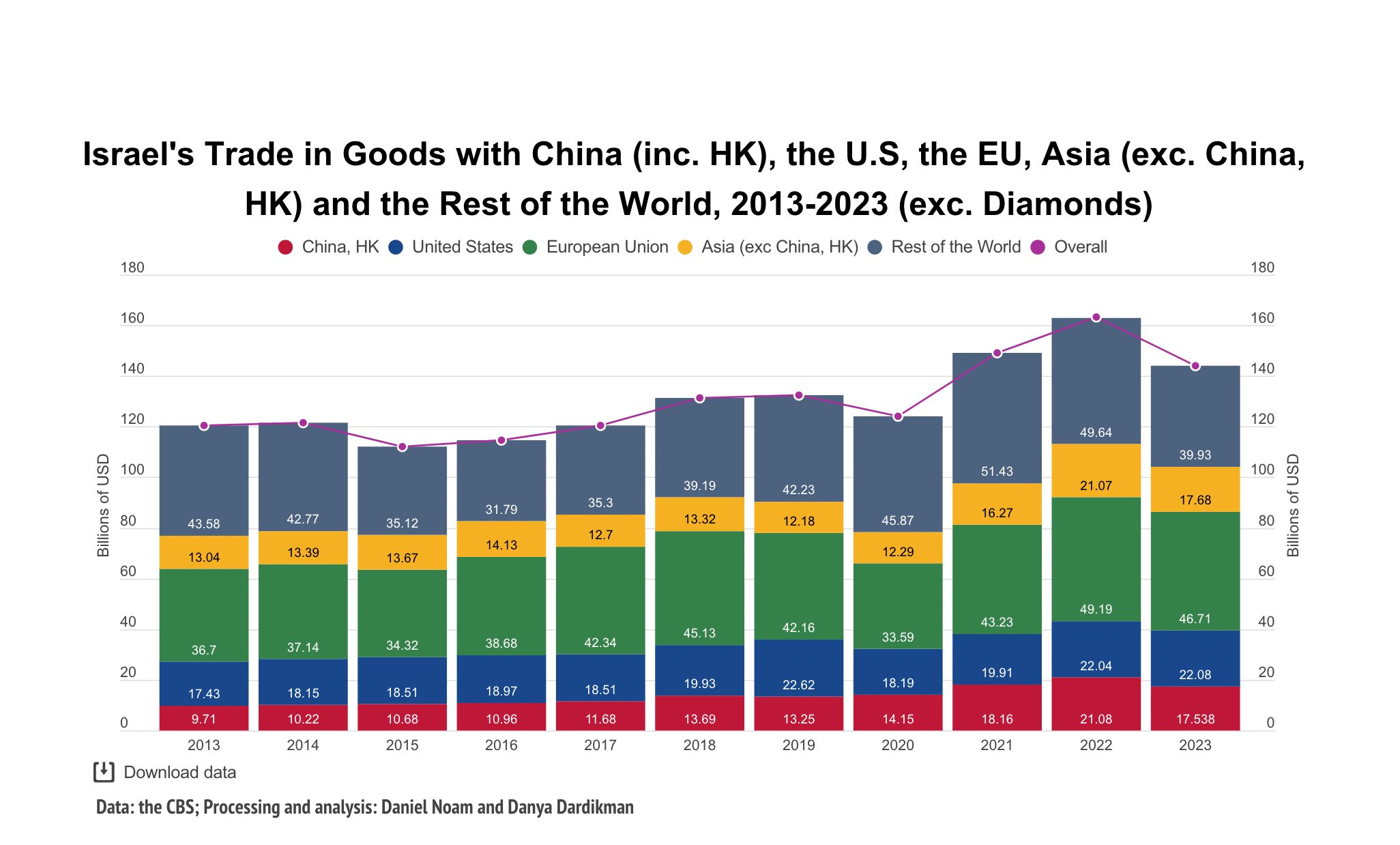Israel – China Trade Slump: Turning Point or Correction?

Special Publication, April 7, 2024
In 2023 there was a sharp decline in the trade of goods between Israel and China, after years of continuous increases, in which China became a significant trade partner for Israel. While the decline could be attributed on the surface to the war in Gaza and the broader threat posed by the Houthis to international trade, these events primarily impacted trade in the final quarter of the year. However, the decline in trade between Israel and China was consistent throughout the year. This paper proposes three possible explanations for this decline: the economic and political uncertainty that characterized Israel in 2023; a general decline in Israeli imports following years of dramatic increases; or a fall in Chinese exports to Western countries.
After years of rising trade volume between Israel and China, 2023 saw a sharp decline. According to the Israeli Central Bureau of Statistics (CBS) figures, in 2023 the total trade between the two countries—excluding diamonds—was $14.5 billion, compared to $17.6 billion in 2022. This represents an 18-percent decrease, the sharpest drop in trade volume since the major financial crisis of 2009.

Furthermore, in 2020, China became Israel’s second most important export destination after the United States (not including the European Union as a bloc, but more than each country in the EU separately). In 2023, exports to China fell to third place, below exports to Ireland, which stood at $3.4 billion. Way above them, exports to the United States reached $13.7 billion. It is important to note that Israeli exports to China have been stagnating for years. Despite a slight rise from 2020 to 2022, the peak year—and even then exports to China did not reach 2018 levels—,when Israel exported $4.77 billion worth of goods to China.
The import of goods from China has always been the main component of trade between the countries, given the negligible volume of trade in services. In 2023, imports declined by 15 percent compared to 2022, from a peak of $13.1 billion to $11.2 billion, after many years of gradual increases and a dramatic jump in 2021 and 2022. For an overall perspective, in the decade from 2013 to 2022, imports from China rose 130 percent, from $5.6 billion in 2013 to $13.1 billion in 2022.
2023’s sharp drop in imports occurred despite a large increase in the import of Chinese electric vehicles to Israel, with this trend also reflected elsewhere. Indeed this was characteristic of Chinese exports to other Western countries throughout 2023: a decline in the export of goods alongside an impressive increase in vehicle exports. In 2023 China broke a vehicle export record with about 5 million vehicles sent abroad, making it the biggest vehicle exporter in the world according to some metrics.[1]
Chinese vehicle brands in Israel had already experienced impressive growth in 2022, selling 15,000 vehicles. In 2023, imports grew even more significantly: According to the Israel Vehicle Importers Association, over 47,000 vehicles produced in China were sold in Israel, comprising 17.4 percent of all vehicles sold. Lacking data available on the value of vehicle imports from China in 2023, we can estimate based on 2022 data that they took up a large portion of the total import of goods from China to Israel. According to the UN trade database Comtrade, in 2022, vehicle exports from China to Israel were worth $1.1 billion, compared to $273 million in 2021.
Trade with China including Hong Kong
Adding the trade in goods between Israel and Hong Kong to the analysis does not bring about significant changes to the overall picture. The World Trade Organization and other economic organizations still assess trade with China and Hong Kong as separate units. However, today Hong Kong is an integral part of the People’s Republic of China, so it is reasonable to consider it together with an examination of trade relations with China. According to CBS data, in 2023 there was also a significant decrease in the volume of trade in goods (excluding diamonds) between Israel and China (including Hong Kong). The total volume of trade was $17.538 billion, a decrease of over 17 percent from $21.08 billion in 2022—the lowest volume of trade between the countries since 2020, when it stood at $14.15 billion.
[1] According to some metrics. Depending on the method of counting vehicle exports, some sources still present Japan in first place in vehicle exports while China takes second place.

Imports to Israel, which are the main component of trade between Israel and China (including Hong Kong), dropped sharply between 2022 and 2023, from $15.83 billion to $13.12 billion. Exports from Israel stood at $4.41 billion in 2023, compared to $5.25 billion in 2022—a 16 percent drop, and the lowest level since 2017. It is worth noting that exports to Hong Kong rose by about 30 percent, from $750 million in 2022 to $1.09 billion in 2023, and for the first time in history crossed the billion-dollar threshold, even without diamonds. The Israeli CBS has not yet published the breakdown of goods in 2023, but according to the Hong Kong Customs Department, most of the increase is attributed to increased export of telecommunications equipment from Israel to Hong Kong. In addition, in July 2023, the Israel Export Institute signed a memorandum of understanding with the Hong Kong Medical and Healthcare Device Industries Association and with a local corporation that operates a network of health centers in Hong Kong. The signing of this agreement is expected to lead to a positive impact on the export of Israeli products in the medical and technological fields in the near future.
Possible explanations for the decline in trade with China
The first possible explanation for the decline in trade with China emphasizes internal factors in Israel over the last trade year. 2023 was characterized by economic, military, and political uncertainty in Israel. For most of the year this was caused by the judicial reform plan, and in the last quarter, by the war in the Gaza Strip. The data on international trade of goods between Israel and the rest of the world similarly reflects this trend. Israel’s total trade declined from a peak of $163 billion in 2022 to $143.8 billion in 2023, an 11.5 percent decrease. Within this, Israeli exports of goods declined from $61.8 billion in 2022 to $56.5 billion in 2023, an 8.5 percent decrease. However, changes in imports had the greatest effect on Israel’s trade volume, with a 14 percent decrease from 2022 to 2023, from $101.4 billion to $87.3 billion. However, the decline in imports from China including Hong Kong (a 17-percent decrease) was greater than the decline in imports from other countries (a 13-percent decrease). The uncertainty surrounding the judicial reform, combined with the upheaval of the war, reduced Israeli private consumption. According to CBS data, household spending decreased by close to 3 percent in 2023. The decrease in private consumption was felt in all four quarters, not just in the fourth quarter, when the war broke out. The war further burdened the Israeli economy in general and the import of goods from China in particular, whether via the Chinese websites that made deliveries to Israel more difficult, or due to the attacks by the Houthis, which endangered the sea-bound import of vehicles to Israel. Trade with China, like with the rest of the world, slowed compared to the first three quarters, but not dramatically. For example, in import data from the fourth quarter of 2023, there is no sharp decline in imports from China compared to the corresponding period in 2022. Imports from China during the months of the war, between October and December 2023, stood at $2.72 billion, compared to $3.29 billion in 2022—a 17-percent decrease; while there was a 13.5 percent decrease in the period from January to September 2023 from the corresponding period in the previous year.
The dominance of imports to Israel in the overall trade volume between Israel and China, means that the decline in private consumption within Israel could explain the sharp drop in trade with China in general.
A second explanation focuses on the unique characteristics of the last few years, which led to the significant increase in imports from China. The increase of over 50 percent in imports from 2020 to 2022, and subsequent sharp decline, could stem from the particular features of 2023, or it could be attributed to the unique characteristics of the COVID-19 era, which led to a surge in demand. As we may recall, the COVID-19 crisis resulted in a significant increase in global imports in general and in Israel in particular—of medical equipment, including masks and gloves—, to cope with the virus, but also for electronic equipment to support remote work. In addition, during the COVID-19 pandemic, a dramatic decline in the consumption of services, including public performances such as concerts, sporting events, and trips abroad, was accompanied by increased orders of consumption of products on the internet, a large portion of which are produced in China. The sharp increase in internet purchases strengthened Chinese exports.
Indeed China supplies a number of very popular internet platforms, including the popular shopping websites AliExpress and Shein. But also beyond Chinese platforms, factories in China produce a large portion of the goods sold at stores around the world and on popular websites such as Amazon. In many areas of the world, including in Israel, those who stayed at home during lockdowns compensated themselves by purchasing (more or less) essential products. This boosted the private consumption of goods, thus increasing exports from China, which—as “the world’s factory”—met the demand and increased the supply of diverse products including clothing, computers, computer cameras, home furniture, toys, sports equipment for home workouts, and medical equipment. According to CBS data, in 2023 there was a decline in all import categories of consumer products, including furniture, clothing, and home appliances.
China’s customs data support this claim, indicating a global decline in Chinese exports of goods in 2023 after years of growth. In 2022 China exported $3.54 trillion worth of goods, while in 2023, the volume of exports was $3.38 trillion, a decrease of almost five percent. From this perspective, the decline that occurred in 2023 comes in the context of several years of dramatic increases that do not represent normal years of trade between China and Israel.
This argument can also be justified by comparing the trade in 2023 to the years before COVID-19. From this perspective, the past year continues the upward trajectory of trade. In fact, the trade volume in 2023 is the highest recorded outside of the COVID-19 affected years, marking a 32 percent increase compared to 2019. However, it is important to note that the decline in trade between China and Israel is sharper than the decline in trade between China and the rest of the world. Aside from the return to normal after COVID-19, according to CBS figures, there was a decline of about 15 percent in the import of raw materials to Israel last year. There may have been a decline in the import of products related to infrastructure work in Israel, especially iron and steel, which Israel imports mainly from Turkey and China.
The third possible explanation, which could also supplement the previous two, is the overall decline in Chinese exports to Western countries. The decline in trading volume didn’t come out of nowhere. The uncertainty surrounding the judicial reform and the war in Gaza harmed private consumption in Israel, as expressed in import figures. But in China too, this decline can be examined in a broader context. According to customs data in China, the decline in the export of goods was not across-the-board and identical for all of its main trade partners. In fact, the variable that explains this decline is mainly exports to Western countries, which declined sharply. The figures from China add another dimension to the data published by the Israeli CBS. As part of the great power competition, Western countries saw a decline in trade with China .
The intensifying great power competition may be reflected in a Western trend aimed at reducing dependency on China, thereby impacting trade statistics. Chinese exports to Japan decreased by 8.4 percent, its exports to the European Union countries decreased by 10 percent, and its exports to the United States decreased by 13 percent. For the first time since 2006, China is not the top exporter to the United States; its place has been taken by Mexico. In contrast, China’s exports increased to non-Western countries—the United Arab Emirates, India, Saudi Arabia, African countries, and of course Iran and Russia. It is important to note that Chinese export of goods to Russia grew by 46 percent last year compared to 2022.

Furthermore, delving deeper into this analysis reveals intriguing dynamics within Israel’s trade relationships. Along with the sharp decline in exports to China, we should also note Israel’s trade with the United States. In 2023 there was a slight increase in the trade of goods with the United States, with $22.08 billion worth of trade compared to $22.04 billion in 2022. The United States continues to be the leading export destination for goods from Israel in general and in the tech industries in particular. The export of goods increased from $13.4 billion in 2022 to $13.7 billion in 2023, a 2.5 percent increase. In the import of goods, there was a decline from $8.7 billion in 2022 to $8.4 billion in 2023, which is a minor decrease of 3.4 percent. However, this still represents the largest ever volume of imports from the United States, excluding 2022. Total trade of goods with the European Union decreased by 5 percent, from $49.19 billion in 2022 to $46.71 billion in 2023. Imports from the European Union decreased from $32.6 billion in 2022 to $29.6 billion in 2023, which is a decrease of 9 percent.
The stagnation of Israeli exports to China during the past five years, in contrast with imports, which increased continually until the current year, adds to this argument. In 2023, Israeli exports to China stood at $3.3 billion—a 26 percent decrease from 2022 and a decrease of over 30 percent from the peak year (2018), when Israeli exports to China stood at $4.77 billion.
This raises the possibility that the current decline in trade with China in general and in imports in particular, is related to broader processes of decoupling or at least de-risking between the Western economies and the Chinese economy. While unlikely that these trends will ultimately lead to complete separation of the two blocs as during the Cold War, there is likely to be a reduction in dependence. It is important to note that in the Western countries led by the United States, this process is already expressed in the trade of technological products and their increased production in friendlier countries. In Israel we do not yet see many signs indicating a similar trend.

Conclusions
The analysis of the data on trade between Israel and China in 2023 raises three possible explanations for the significant decline in trade between the two countries. The first explanation is the decline in private consumption against the backdrop of the judicial reform, and in the last quarter of the year, as a result of the war in Gaza, which greatly impacted Israeli household spending. This decline is across-the-board and is expressed in a decline in imports not only from China, but also from other countries. However, the decline in imports from China was greater than the decline in imports from other countries. The second explanation is a “return to normal” after the peaks during the COVID-19 pandemic. The COVID-19 pandemic changed the consumption habits of Israelis but also those of residents of other countries around the world. The lockdowns between 2020 and 2022; changing work environments that included remote work; and the increased the consumption of many goods from digital stores to replace leisure activities involving the consumption of services such as vacations, concerts and dining out, all had an effect. This phenomenon significantly increased Chinese exports during the years of COVID-19 and it was only natural to expect a certain decrease in 2023, when the world returned to normal. Israel, of course, experienced the same phenomenon, and in Israel too, the end of COVID-19 involved saw increased spending on services compared to the years of COVID-19, which may have reduced the demand for goods. The third explanation focuses on the broader context—the desire of Western countries, chiefly the United States, to reduce their dependence on China for geostrategic reasons. Chinese customs figures reporting a decline in exports show unequivocally that the trend is expressed first and foremost in exports to Western countries. But as of now, this explanation is not supported by public declarations in Israel, as it is in other countries such as the United States, who are intentionally trying to reduce their dependence.
The sharp decline in trade with China may indeed be attributed to a combination of the three explanations outlined here, although it seems more likely the result of a combination of the first two. Regardless of which explanation proves to be correct, the figures speak for themselves. In effect, after years of significant increases, the share of trade with China (including Hong Kong) declined in 2023. Trade with China was about 12.9 percent of Israel’s total international trade in goods in 2022, while in 2023 it declined to 12.1 percent. In addition, the figures are significant because trade relations between Israel and China are based primarily on goods; trade in services is almost nonexistent. In other words, even when the figures on trade in services for 2023 are published, they are not expected to compensate for the decline in the trade of goods. Moreover, the figures come against the backdrop of a dramatic rise in the import of vehicles from China. The low taxes on electric vehicles and the penetration of Chinese vehicle brands into the Israeli market boosted the import of vehicles from China as a central component of trade in 2022-2023. However, we can cautiously estimate that the tax hike on electric vehicles from 20 to 35 percent in January 2024 will moderate the sharp rise in vehicle imports from China and is expected to further lower the volume of trade between Israel and China. The 2024 figures may clarify whether this represents a turning point in trade relations between the two countries, or perhaps a one-time slowdown resulting from the unique circumstances of 2023.
____________________________________________________________
[1] According to some metrics. Depending on the method of counting vehicle exports, some sources still present Japan in first place in vehicle exports while China takes second place.


